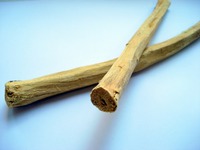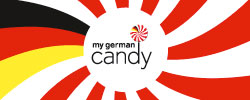- Home
- Kaffee Klatsch (our Blog)
- what is licorice
Kaffee Klatsch (our Blog)
Recent Posts
Black Gold - Candy History Licorice Part 2
Posted by on
Welcome to the second part of our short story of licorice...
Todays knowledge confirms that Licorice has a calming effect on throat and the stomach. But there also is a warning, as with all medicine products (nature or manmade) there are side effects when you not use it probably: glycyrrhizin, the active ingredient of licorice, stimulates the circulation of the blood, which is why the consumption of Licorice (pure extract) should only consumed in small amounts (about 5 g - 0.18 Oz / day). Most Licorice Candys have just a very small amount of glycyrrhizin, but you always should „use“ Licorice as what it is a Candy treat.
Glycyrrhizin is the sweet-tasting constituent of the licorice root. For example it is used in Japan to prevent liver carcinogenesis in patients with chronic hepatitis C.
But back to history: how and when this „medicine“ has made it into a candy is not really clear.
There are the rumors about the family Dunhill, licorice farmers in Pontefract in Yorkshire, England. They offered the root and, boiled them, then they sold the first licorice as loafs on the local farmers market. It is said that one day a sugar pot had slipped into the dough and after a taste they found it very delicious. Later they produced not loafs of it, they cut the loafs in tiny pieces just like a coin and sell it as Pontefract cakes. We still sell them in our store today (but there are very often sold out!). They have a very own more mild taste. You have to try it - the „original“ is made today by the Brand „Haribo“ a well-known german candy company and the also used the Dunhill brand for that product. All the products that we have from Haribo are European - mostly german or British - items. We don’t sell american or Mexican versions, due to the receipt changes in those products.
Licorice, which grows best in well-drained soils in deep valleys with full sun (why we don’t have any licorice planate here in California??), is harvested in the autumn two to three years after planting. Afghanistan, India, Iran, China, Pakistan, Azerbaijan, Uzbekistan, Turkmenistan, and Turkey are todays biggest grower of licorice plants. In Pontefract in the United Kingdom today are still the manufacturing factories but the plantations are long gone - and they don’t use their own licorice plants any longer. We have found a very interesting video about Pontefract and the making of Licorice; have a look here in the Video Section from Pontefract Cakes

Black Gold - Candy History Licorice Part 1
In this small series I will try to get some light behind the history of the „black eatable gold“ of licorice.Wikipedia says the word licorice is derived (via the Old French licoresse) from a Greek word (glukurrhiza) and meaning "sweet root“. It is usually spelled liquorice in British usage, but licorice in the United States and Canada.Licorice is used and [...]
 Loading... Please wait...
Loading... Please wait...
